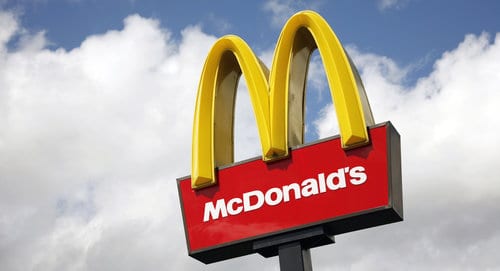Not many people associate fast food with clean energy. But that’s exactly what one of the largest quick-service restaurants in the world is exploring. RMI recently completed a net-zero-energy study for McDonald’s, which explores how to offset the energy consumption of an entire restaurant with renewable energy.
Working alongside the net-zero-energy visionaries at New Buildings Institute (NBI) and kitchen equipment experts at Fisher-Nickel, Inc., RMI looked critically at the technical and financial feasibility of achieving net-zero energy for a McDonald’s restaurant. The study builds on previous work performed by a group of Duke University graduate students (with support from RMI), in tandem with prior energy-efficiency studies and LEED designs developed by McDonald’s.
To achieve net-zero energy (NZE), a McDonald’s restaurant must offset its energy consumption with on-site renewable energy generation on an annual basis. Restaurants have a high energy density (a lot of energy used within a small physical footprint), which makes them challenging candidates for net-zero energy. High energy density requires a costly solar system, making energy efficiency critical to reaching net-zero energy on a standard site with reasonable first costs. The study reveals a number of energy-efficiency opportunities throughout the building, and more thoroughly examines kitchen equipment, which is the most significant building energy end-use in a McDonald’s restaurant.
INCREASING BURGER EFFICIENCY
So what is the minimum amount of energy required to cook a burger? A side of fries? What about the energy used to keep your drink cold? Based on the study, kitchen equipment represents the greatest opportunity for energy savings, as it can consume more than 50 percent of the energy in a new McDonald’s restaurant. By considering the minimum amount of energy required to cook each menu item and comparing this with actual kitchen equipment energy consumption, the RMI team uncovered both near-term and future kitchen equipment upgrades that can cut kitchen energy use in half. The team’s analysis uncovers opportunities to reduce idle energy consumption (equipment energy consumption when food items are not being cooked) and increase overall kitchen equipment efficiency without substantially changing McDonald’s operations.
McDonald’s has been driving its kitchen equipment suppliers to improve energy efficiency for years, and the company currently encourages the use of low-oil-volume fryers and custom exhaust hoods that make ventilation more efficient (which also reduces heating and cooling loads). However, more opportunity exists—both in the kitchen and throughout the building. With the results of this study, the McDonald’s team can work with key equipment suppliers to focus on improving the most energy-intensive pieces of equipment and combining pieces of equipment where practical.
BEYOND BURGERS
In considering net-zero energy, the team did not focus on burger production alone. The menu has other items, and the building has other needs, such as keeping its customers and employees comfortable. The team took an integrative, whole-systems approach to understanding the ways that building systems interact, and leveraging the interactions between building systems.
While the kitchen may be the primary energy consumer, other building systems, including HVAC (heating, ventilation, and air conditioning), play a key role in achieving net-zero energy. HVAC energy consumption is very closely tied to kitchen equipment energy consumption. Not only does the kitchen equipment heat its surroundings, but the cooking process requires mechanical ventilation to maintain indoor air quality. The use of targeted ventilation strategies, paired with solar thermal, geothermal, and waste heat loops, could save up to 90–95 percent of HVAC system energy in a NZE store. The team’s strategy also consolidates HVAC and refrigeration equipment and uses advanced control strategies wherever possible to reduce equipment capital costs while reducing system energy consumption.
Building lighting systems are another key area of focus for this study. The study shows up to a 60-percent reduction in lighting energy consumption is possible while also decreasing lighting system capital costs. Improved system design can produce the same light levels as a traditional lighting design using fewer fixtures. Falling LED prices, increasing LED efficiency, and targeted lighting system designs (including natural lighting with skylights) enable this level of energy reduction.
The team uncovered a number of solutions related to the HVAC, lighting, and refrigeration systems, in addition to building envelope, kitchen equipment, and other building load improvements. Where possible, system efficiencies were improved, passive strategies were used, equipment was combined, and waste heat was recovered. Energy efficiency solutions were assessed (using equipment-specific analysis and whole-building energy modeling), prioritized, and packaged into a recommended net-zero energy solution.
GETTING TO NET ZERO
The net-zero energy solution recommended to McDonald’s is an all-electric restaurant that would achieve 60 percent energy savings and 90 percent energy cost savings. A 300 kW on-site solar PV system, installed primarily over the parking areas, would provide the energy needed to reach net-zero energy within the footprint of a typical McDonald’s site. The restaurant would offer the same menu and operating hours, and when the sun isn’t shining, it would draw electricity from the utility. While the recommended scenario includes some kitchen technologies that require further development, a separate scenario shows that net-zero energy is achievable today with available technologies at a significant incremental cost.
One of the team’s recommendations is for McDonald’s to pilot an innovative “integrated thermal loop,” that joins solar thermal collectors, waste heat capture, and a geothermal heat pump together to efficiently deliver the space heating, space cooling, and service hot water required by the restaurant. This loop, while similar to those used in net-zero-energy buildings such as the Walgreen’s net-zero-energy retail store, could be expanded in the future to include key pieces of kitchen equipment.
TAKING THE STUDY TO THE BANK
“The net-zero-energy study has become the North Star that will continue to guide our efforts to improve the energy efficiency of our new and existing restaurants,” says Roy Buchert, Global Energy Director for McDonald’s. McDonald’s is likely to leverage this net-zero-energy study to drive further efficiency in new and existing McDonald’s restaurants where it makes business sense. For these restaurants, it is important to leverage existing upgrade opportunities, including equipment swap-outs and interior remodels, to reduce first costs and prevent any disruptions to operations. Many efficiency upgrades include simple, non-invasive changes that could be implemented with minimal disruption.
Building upon the net-zero-energy study, McDonald’s plans to prioritize the findings over time to map alongside its business objectives, and has identified the following steps.
- Explore recommended energy-efficiency strategies, including research and development to further improve kitchen equipment efficiency, in order to reduce overall NZE costs
- Potentially design and build a pilot NZE restaurant in the future to act as a “learning lab” to test and validate new technologies
- Identify one or more vendors to design, deliver, and maintain large solar installations on standard McDonald’s sites, while securing incentives and financing as necessary
- Engage with the restaurant industry and suppliers as appropriate to help drive future improvements
RMI believes McDonald’s can leverage this study to change the way that we think about energy. Developing the first net-zero-energy quick-service restaurant and driving deeper savings within existing restaurants can spur radical changes and transform the quick-service restaurant industry’s approach to energy. As the largest U.S. and global presence in this industry by revenue, McDonald’s has the power to drive equipment improvements, influence other key players in the industry, and deliver hundreds of millions of dollars in energy savings across the industry each year.
Source: RMI. Reproduced with permission.










